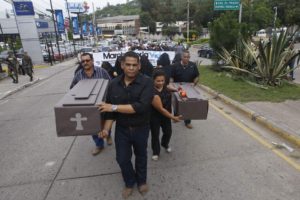What the Socceroos won’t see in Honduras
When Australia’s Socceroos face Honduras this weekend, they will see a wall of passionate local fans, maybe some smoke flares and, according to sports pundits, a well organised defence.
 They will also see armed guards, an inflatable tunnel outside their hotel and personal bodyguards; all offering them protection from overzealous local fans.
They will also see armed guards, an inflatable tunnel outside their hotel and personal bodyguards; all offering them protection from overzealous local fans.
What they’re unlikely to see is the ugly and disturbing underbelly of a place known as ‘the nation of refugees’.
Two decades ago, Honduras, a small Central American country nestled between Guatemala and Nicaragua, was home to a rich, cultural heritage, stunning wildlife, beaches and forests.
But despite the beauty this country has to offer, many of its citizens are now seeking a safe haven far away.
Tens of thousands – maybe hundreds of thousands – of unaccompanied Honduran child migrants, along with more from El Salvador and Guatemala, have been detained in the US or are in Mexico trying to get there.
This situation has been fueled by the growth of drug trafficking and gang activity in Honduras.
Honduras is struggling with an astronomical homicide rate. The country is currently tied with El Salvador for highest homicide rate in the world and in 2015, more than 18,000 were recorded across the Northern Triangle, which comprises Honduras, El Salvador and Guatemala.
Many of these killings are related to gang activity. Citizens of Honduras run the risk of being extorted by these groups and are often threatened with violence if they are unable to pay ‘fees’.
Honduras is a dangerous place to be a women. The UNHCR reported that women fleeing the Northern Triangle often report being assaulted, extorted and threatened. Honduras averages at 10.9 female homicides per 100,000 people. In comparison, the same statistic for the US is 1.9 per 100,000.
The number of Honduran refugees is growing. Nearly ten per cent of the region’s 30 million citizens have fled in the past 10 years.
An analysis from the Council on Foreign Relations said that the amount of people from Honduras, El Salvador and Guatemala living in the U.S. increased from 1.5 million to 2.7 million between 2000 and 2013.
In addition to the threat of violence, Honduran refugees may also be fleeing from their countries for climate-related reasons. Honduras is experiencing prolonged drought effects due to the El Nino weather phenomenon.
This drought is having a severe effect on food prices and on farming in the country. Bean and maize harvests have been cut in half due to the drought leading to an increase in food prices.
Malnutrition is a serious risk for families. The UN’s World Food Project reports that around a quarter of children aged six months to two-and-a-half years struggle due to chronic malnutrition.
So, it’s not difficult to see why so many Honduran parents make the decision to send their children unaccompanied on such a dangerous journeys.
What makes things worse is that many Honduran refugees do not fall under the traditional definitions of the word enshrined by the 1951 Refugee Convention.
Most of the people widely considered to be refugees by the convention are fleeing more traditional political or ethnic conflicts like those in Syria or the Sudan. Central Americans would be among the first modern migrants considered refugees because they are fleeing violence and extortion at the hands of criminal gangs.
Gaining refugee status would be good news for the migrants, because it would mean they would not automatically be deported to their home countries. Instead, they would receive international protection – just like Australia’s visiting Socceroos.
Laurie Nowell
AMES Australia Senior Journalist












